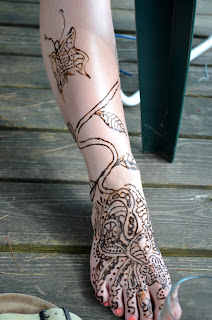 |
| plaster bandage finger puppet |
I've been involved in some discussions in an art teachers' group on Facebook, and a recent discussion prompted me to write this post. I was asked about my curriculum. So today, I'm going to share my personal philosophy of teaching art, with a rundown of the way I ran my program until my retirement. It's not so much a curriculum as it is an overview, a general plan. If you are a long-time reader of this blog, you probably already know a lot about this. But if you you have recently found your way here by way of the Facebook group, or Pinterest, or an Internet search, there's a lot you don't know about me and my teaching style.
*By the way, I am filling this post with a random smattering of student artwork. It will not always match the text. I just want you to see the type of stuff my kids might have done in my program.
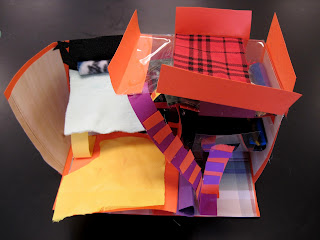 |
| 4th grade room design construction |
So, some background. (Feel free to skip this paragraph if you are not interested.) I am one-year retired, after 36 years teaching. I began as a high school art and photography teacher, but spent the last 27 years in the district that I retired from, teaching elementary and some middle level art. This job was in a small rural school district in northern NY, about 500 kids in the whole district. For the first 14 or so years in this job, I taught in two buildings, in two tiny towns. When I began, my classrooms were either nonexistent or inappropriate, and shared. It was not ideal, but I did not let it hinder the creation of art. Then my district got some funding and abandoned their three inadequate schools and built a central Pre-K-12 building. The high school art teacher and I suggested that our rooms be central to the building and adjoining, so that we could share expertise. Instead, we were placed at the extreme opposite reaches of the large building. Our schedules didn't jive, so we never saw each other. In other words, my art program existed as an island, and I was really on my own for deciding what to teach and why. Until I began blogging three years ago, my only contact with other art teachers was, for the most part, my attendance at annual conferences. So I figured things out for myself.
 |
| Andy Warhol inspired cat paintings, grade 3 |
I have an extreme distaste for jargon. Giving things fancy names doesn't validate anything for me. And frankly, I learned very little jargon in my hippy-dippy college education in the early 1970's. Over the years, I have seen all sorts of initiatives come and go. There have been been local and statewide and national regulations and programs. There have been professional development programs in my district, where the 'specials' teachers were practically ignored. There was the NY State Regents Action Plan of the 80's. In the 90's nationally there was Goals 2000. Locally there was Learning Focused Schools. And of course, No Child Left Behind, Race to the Top, and now the Common Core. After seeing so many changes come and go over the years, I am always skeptical about investing too much in a new initiative, since in a few years something else will come along. But while I miss my students, quite frankly I'm happy I retired before I had to deal with the new direction in education, which seems to spend way too much time devoted to assessing and assembling data and less time for the joy of actually teaching and learning. This one seems like it might stick around. Anyhow...
Here's what I believe: I believe that art class should be a hands-on opportunity for kids. If you are afraid of making a mess you should not be an art teacher. The good thing, of course, is that you will have less behavior problems if your kids are actively engaged in hands-on experiences. Don't give up those messy materials for something easy to clean up due to lack of space, time, or energy. You are cheating the kids.
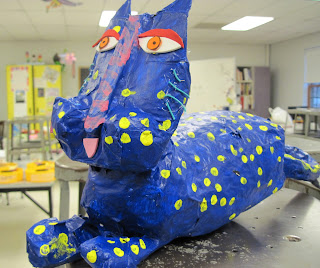 |
| 5th grade special education student's papier-mache Laurel Burch inspired cat |
I do not like the idea of spending elementary art class time giving tests. I also have no interest in learning about incorporating iPads or other technology into elementary art programs. The kids spend so much of their time now, both in school and at home, in front of a screen, using some sort of technology. So I believe an elementary art program should be the one guaranteed opportunity during the day for tactile experience. I want students to experience dipping a brush into thick creamy paint, squishing their fingers through clay or papier-mache goo, squeezing Elmer's Glue-All out of a bottle, cutting, tearing, weaving, drawing, painting, and creating.
 |
| expressing emotion with thought bubbles |
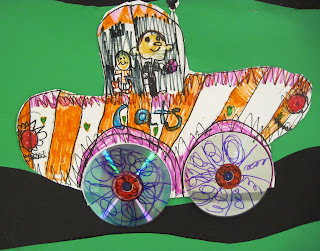 |
| Rizzi cars! |
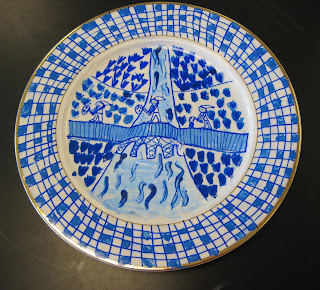 |
| 6th grade Blue Willow inspired plate design |
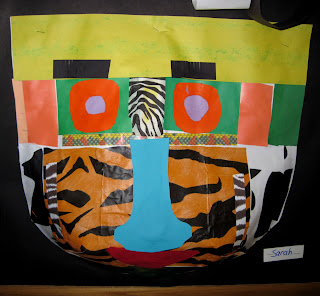 |
| leftovers mask |
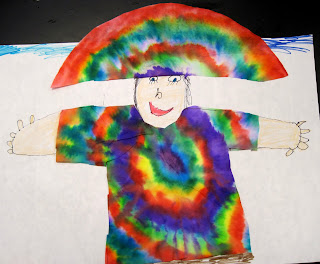 |
| coffee filter creation |
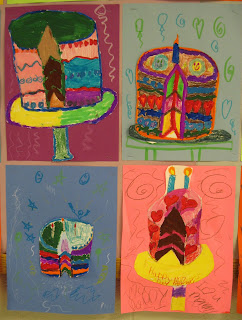 |
| no explanation needed! |
By the time they left my program, I wanted my students to have experienced drawing, painting, collage, printmaking, cutting, gluing, weaving, constructing, and more. I want them to learn to use their eyes and their imaginations, to find creative solutions to challenges, and make independent decisions. I wanted to expose them to a variety of well-known artists, art trends, and cultures. I wanted them to learn to appropriately use and clean up art materials responsibly, and be good class citizens. And certainly I wanted them to have an understanding of how to use line, shape, color, etc effectively in their artwork.
 |
| 4th graders learn to use charcoals and draw trees |
I had a NO WHINING, NO COMPLAINING policy in my room; the art room should be a happy place. I wanted and had a program flexible enough to change directions for something exciting, a spontaneous learning experience.
As for specific curriculum - what I actually taught - I do need to say it varied from year to year.
I did not
drill the
Elements and Principles of Art (though posters hung on my bulletin board all year and were frequently referred to), but instead incorporated them into every lesson. I think it is more important for kids to understand
how to use line and color and texture, for example, than to memorize facts, though vocabulary was added to my word wall all year. I found that almost every art project uses more than one or two elements, so to say "this is a line project" is kind of limiting. Perhaps we are using line to create the illusion of space, using line to create shape, using line to establish rhythm or movement... Perhaps the color of the line is significant. Perhaps the lines you are using create value and texture... you get the idea, right?
I also introduced students to the work of 'famous artists' and art movements and incorporated these into projects throughout the year. I kept careful track of the artists I introduced, and varied them from year to year so that we could study one artist across several grade levels. One year might be VanGogh, Mondrian, Cassatt, and Jackson Pollock; the next could be Chihuly, Rizzi, Lichtenstein, and Janet Fish; and the next might be Nevelson, Matisse, Klimt, and Frank Lloyd Wright; and the next could be Arcimboldo, Kandinsky, Warhol, and Grandma Moses; and so on. Sometimes artists/styles were displayed and studied together - such as Dali and Magritte. Or perhaps I might display landscapes/seascapes by Cezanne, and Monet, and Winslow Homer. Or self-portraits by everyone from vanGogh to Rembrandt to Suzanne Valadon. Or we might compare/contrast Frank Lloyd Wright with Victorian architecture.
 |
| Matisse-inspired painting/collage |
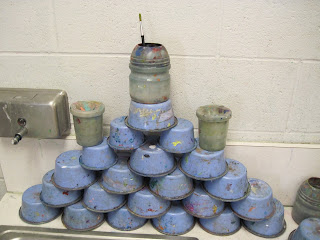 |
| a little art room cleanup! |
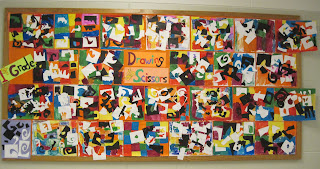 |
| 1st grade Matisse inspired painted collages |
 |
| 3rd grade drawings |
 |
| 1st grade family portrait |
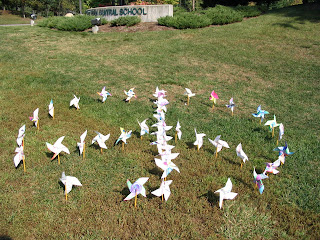 |
| Pinwheels for Peace installation |
All grade levels used a variety of materials and created both 2-D and 3-D art
every year. For storage purposes, I 'choreographed' the 3-D projects so they did not happen all at once. I did papier-mache with grades 3-5 every year, though I rotated the projects so I wasn't doing the same thing each year. My 6th graders always did some sculptural project with plaster bandage. (I saved the more pricey materials, such as the plaster bandage and tooling foil for the 6th grade, who were my oldest students in recent years.) I only had air dry clay, so I used it just with the younger grades. Certain 3-D projects came to be expected every year: My second graders always made cardboard 'teddy bear chairs', and my first graders made cardboard sculptures. 4th graders used shredded paper clay (messy! fun!) to create hunks of 'cave wall' when they learned about Lascaux and the origins of art.
 |
| papier-mache Darumas, Japanese inspiration |
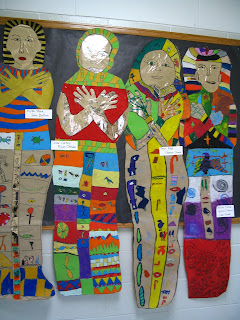 |
| 6th grade mummy cases with hieroglyphics |
We often used other cultures for inspiration. The 6th grade academic curriculum in particular was easy to coordinate with - for example, we always did something Egypt-related.
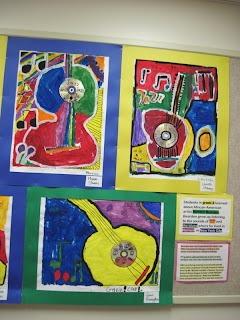 |
| paintings by grade 2 |
Every year, as much as possible all my students would use/experience:
- Watercolors, tempera and acrylics. Painting would include using both traditional brushes, and non-traditional, such as Q-tips, cardboard scrapers, fingers, squirt bottles, rollers, etc.
- A variety of drawing materials including possibly pencils, crayons, chalk pastels, oil pastels, colored pencils, markers, and more.
- A variety of collage materials.
- 3-dimensional materials such as papier-mache, plaster bandage, clay, cardboard, fibers, etc
- Grades 3 and up were exposed to perspective, with the understanding and challenge of what we did a little more complex each year.
- Drawing from life - whether it was 1st graders 'modeling' for the class to draw, or the time we brought in animals (a parent did taxidermy), or a still life setup, or contour drawing from objects in the room; I much rather kids draw from life than copy photos when possible.
 |
| toothpaste batik in process |
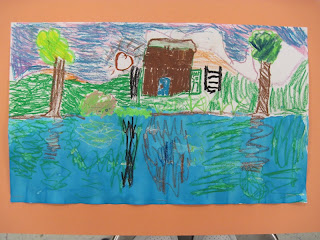 |
| reflections |
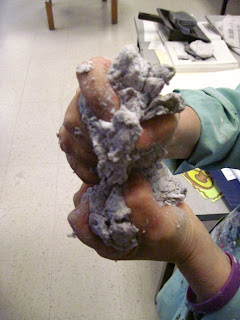 |
| making 'rock' for cave wall paintings |
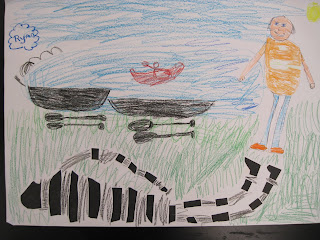 |
| grade 1 - 'I have a little shadow' |
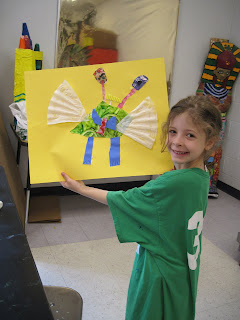 |
| kindergarten collage |
While I am not going to go into detail, I had (have) a document that details 'exit goals' - so that students leaving my programs at the end of grade 6 would be expected to have experienced. everything on my list.
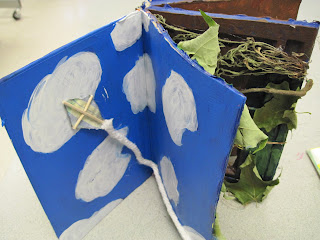 |
| 6th grade altered book |
I tried to foster independence in my classroom, and have students 'take ownership' of their work, their behavior, and the care of my room and materials. I did not use templates, except rare instances. (A circle tracer would be acceptable, for example.) To me, by having everyone trace a template so that 'everyone's work turns out good' takes ownership from the student. He is more likely to say 'I can't draw a cat' for example, if every time you draw cats in the art room you give him one to trace! Instead, give him the experience/tools/practice to learn to draw that cat on his own, and he'll take ownership of and be more proud of his work. Does this make sense to you? My goal isn't simply to have the students create a nice product, but to give them the tools to use their own decision-making and make a product that they really 'own'.
 |
| kindergarten pinch pots |
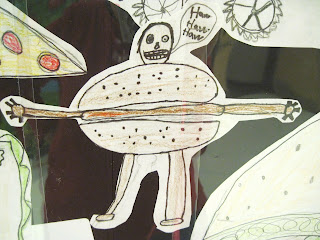 |
| from the Salvador Deli |
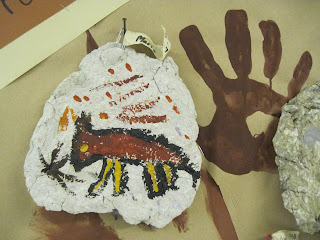 |
| cave wall hunk |
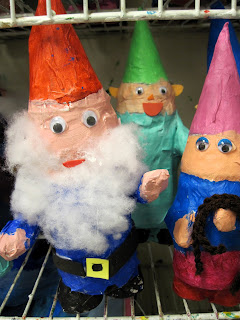 |
| papier-mache garden gnomes, grade 3 |
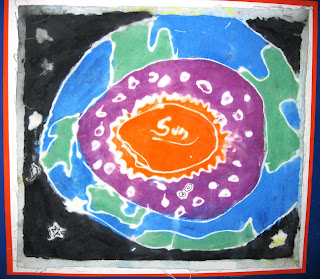 |
| toothpaste batik |
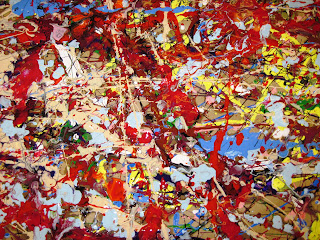 |
| collaborative Pollock painting |
 |
| silly kids |
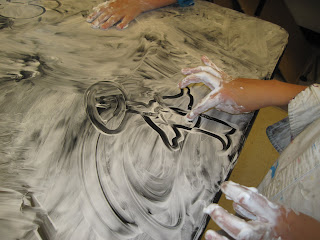 |
| shaving cream! |
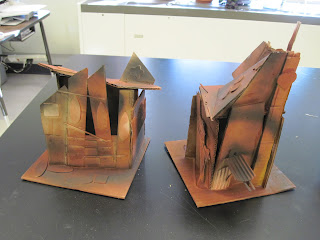 |
| 4th grade cardboard crooked houses |
Hubby is waiting for me to go somewhere - gotta run! I hope this post isn't too long and convoluted! And I hope I finished it! Let me know if you have questions about particular artwork posted, or anything else!










































